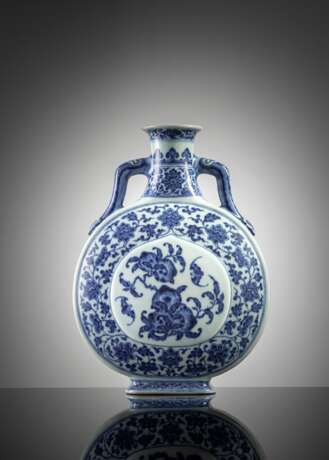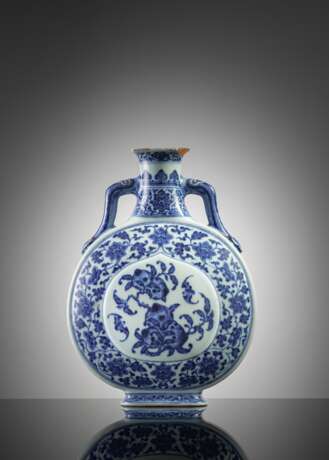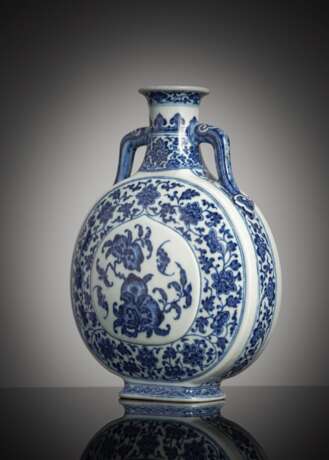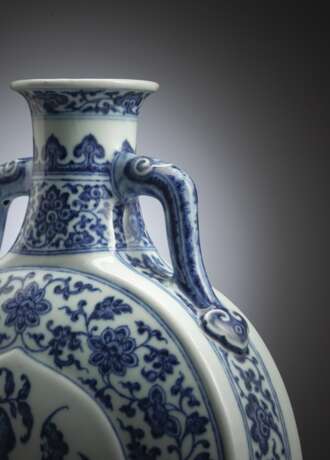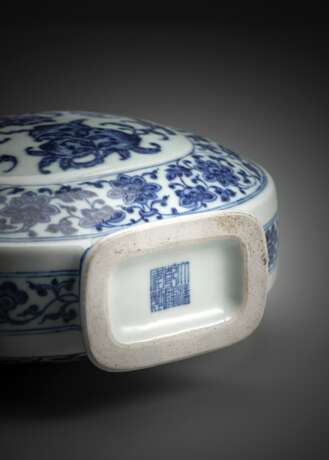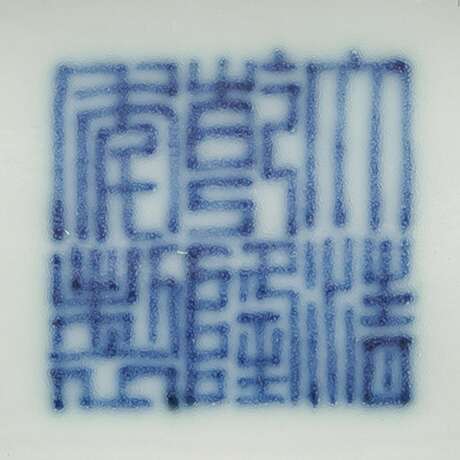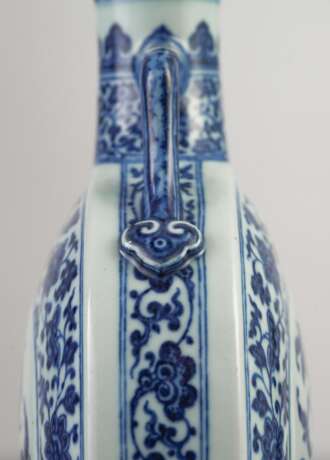ID 1094239
Lot 381 | Unterglasurblaue "Pfirsich"-Mondflasche 'bianhu'
Estimate value
€ 6 000 – 10 000
H. 24,4 cm
Abgeflachte Form, die auf einem gespreizten rechteckigen Fuß steht und auf jeder Seite mit einer erhabenen pfirsichförmigen Kartusche in Relief versehen ist, die mit zwei Fledermäusen im Flug bemalt ist, die Pfirsiche umkreisen, die aus einem knorrigen, belaubten Zweig entspringen. Der Körper ist außerdem von sich schlängelnden Lotusrollen und zwei Lingzhi-Bändern umgeben, die entlang der Seiten verlaufen, der schmale Hals wird von einem Paar ruyi-förmiger Griffe flankiert, mit weiteren Lotusrollen und einem Dreiblattband unterhalb des umgedrehten Randes.
Ehemals aus einer alten Berliner Privatsammlung, vor 2007 gesammelt
Die Form der vorliegenden Mondflasche ist von Prototypen aus dem frühen 15. Jahrhundert aus der Yongle-Zeit inspiriert. Diese wiederum leiten ihre Form von islamischen Metallflaschen ab. Die subtile und abwechslungsreiche blau-weiße Farbgebung imitiert das aus der frühen Ming-Dynastie importierte Kobaltblau mit hohem Eisengehalt, was zu dunkelblauen Flecken auf der Oberfläche führt, die auch als "Heaped-and-piled" Effekt bekannt sind.
Diese Mondflasche gehört zu einer Gruppe von kaiserlichem Porzellan, das von der kaiserlichen Haushaltsabteilung entworfen wurde - etwa dreißig an der Zahl -, die im kaiserlichen Archiv der Qing-Dynastie als Tagesunporzellan bezeichnet werden und in der Herbst- und Wintersaison an den kaiserlichen Hof geschickt wurden. Diese Entwürfe wurden bis zum fünfundzwanzigsten Jahr der Daoguang-Periode, d. h. 1845-6, hergestellt, obwohl die Menge vom Kaiserlichen Haushaltsministerium streng kontrolliert wurde; siehe Wang Guangyao, Official Designs and Imperial Porcelain: The Palace Museum's Collection of Official Porcelain Designs and Porcelains from Imperial Kilns of the Qing Dynasty, Beijing, 2007, S. 15-16. Ähnliche Mondflaschen finden sich in bedeutenden Museumssammlungen: siehe T. Yoneyma, Qing Dynasty Porcelain from the Seikado Bunko Art Museum, Tokyo, 2006, S. 58, Nr. 49; eine weitere im Nanjing Museum, abgebildet in The Official Kiln Porcelain of the Chinese Qing Dynasty, Shanghai, 2004, S. 220; vgl. auch eine weitere aus dem Indianapolis Museum of Art, abgebildet in Beauty and Tranquility: The Eli Lilly Collection of Chinese Art, Indianapolis, 1983, Nr. 116. Ein sehr ähnliches Gefäß mit einem Jiaqing-Siegel aus der Sammlung des Qing-Hofes ist in The Complete Collection of Treasures of the Palace Museum abgebildet: The Complete Collection of Treasures of Palace Museum: Blue and White Porcelain with Underglazed Red (III), Hongkong, 2000, Pl. 148, abgebildet, was die Beliebtheit und Kontinuität dieser Form und dieses Designs zeigt - Am Rand gefüllter Abschlag und Glasurabsplitterungen
| Address of auction |
Nagel Auktionen GmbH Neckarstrasse 189 - 191 70190 Stuttgart Germany | ||||||||||||||
|---|---|---|---|---|---|---|---|---|---|---|---|---|---|---|---|
| Preview |
| ||||||||||||||
| Phone | +49 (0)711 649 690 | ||||||||||||||
| Fax | +49 (0)711 649 69696 | ||||||||||||||
| Buyer Premium | 29,5% | ||||||||||||||
| Conditions of purchase | Conditions of purchase | ||||||||||||||
| Business hours | Business hours
|
